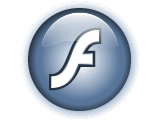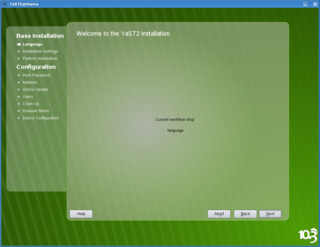If you need to type a diacritical mark such as an acute "e" (é) — let alone a character not found in a Western European language — the standard English keyboard layouts for GNU/Linux users are barely ahead of those of typewriters. However, adding support for both extended characters and multiple keyboards has become much easier in the last few years. These days, you can quickly add extended character support from both GNOME and KDE, and, should either desktop fail you for any reason, you can fall back on other methods to improve your input.
Category Archives: news
Full-featured traffic analyzers for Linux systems such as ntop and vnstat are widely available, but sometimes you just want a simple program that gives you fast, basic information about the amount of traffic going in and out of the hosts on your network. Darkstat, a packet sniffer that runs as a background process, fills that role. It gathers statistics about network usage and displays them over HTTP.
 Two days ago Adobe has released the final version of its Flash Player Update 3, an important update that brings several new features:
Two days ago Adobe has released the final version of its Flash Player Update 3, an important update that brings several new features:
- Mainly, support for H.264, one of the most efficient video encoding available today
- Hardware based image scaling
- Full screen support on Linux
- Support for HE-AAC, an advanced audio encoding
- Multicore support
- Support for Leopard (Mac OS 10.5)
- Support for Microsoft Active Accessibility (MSAA)
- Flash Player can play back existing MP4, M4A, MOV, MP4V, 3GP and 3G2 content
To get the update, available for Windows, Mac OS X, Linux and Solaris, visit Adobe Flash Player Download Center.
At the same time, Adobe announced Adobe Media Player: “the first application from Adobe built on Adobe AIR, [that] will leverage both H.264 video and HE-AAC audio support. Adobe Media Player takes Flash streaming video experiences outside the Web browser delivering more viewing options, such as watching videos anytime, anywhere.â€
Adobe Media Player will be available in early 2008 according to the same press release.
Adobe Flash 9 Update 3 press release   |   Adobe Flash 9 Update 3 release notes
Stephan Kulow writes on his blog to inform us about his successful attempts in getting YaST ported to Qt4:
“Certain voices claimed, porting Yast to Qt4 would be almost impossible due to the different event loops and threading and all that. But thanks to Thiago’s little explanations on how things to go together, it was actually a job done pretty quickly (it was once tried in july, so I didn’t start from scratch). Damn! Did I say, I have the rest of the year?”
Here’s a screenshot of what can be done with a little editing of the styles:
Looking nice … click for bigger picture.
How are GNU/Linux users preparing for Linus Torvalds’ plan of world domination? By playing free software computer games based on the classic world conquest board game Risk. You can perfect your strategy by playing the games XFrisk, TEG, or Ksirk.
Linux.com ran an article headlined GNOME Foundation defends OOXML involvement on November 23. Jeff Waugh, the press officer on the GNOME Foundation Board, was prominently mentioned in that article and in several others to which it links. So was Roy Schestowitz, who wrote a post titled Anti-symbiosis: ODF, OOXML, Mono, GNOME, and OpenOffice.org on the Boycott Novell site, where he is a regular contributor. We thought getting them together might be illuminating. After-show update: And it was illuminating, despite some tech glitches at the beginning. Here’s the MP3 download.
The GNU/Linux desktop lacks a font manager for design work. Ideally, such a font manager should support currently used font formats, including TrueType, Type1, and OpenType, and allow sets of fonts to be activated on the fly, so that system memory is not choked with rarely used fonts. Until now, the closest to this ideal has been Fonty Python, but, when last seen, it fell short because of it supported only TrueType fonts and had a needlessly complicated interface. Now, however, newcomer Fontmatrix has proved itself a contender for the role. In fact, despite some weaknesses in its features, its basic functionality is already dependable.
Standing next to your laptop to control the slides during a presentation is not cool. Nowadays everyone uses a presentation device or their laptop’s remote controller, but a presentation device can be expensive, few laptops come with a remote controller, and for those that do, Linux compatibility may be an issue. The Amora project turns your Symbian mobile phone into a Linux presentation device using Bluetooth.

In case you are interested in how to run Opera Mini 4 on you Windows Mobile device as a default browser, head to my other blog post here …. cause I am loving it.
 ÐналитичеÑÐºÐ°Ñ ÐºÐ¾Ð¼Ð¿Ð°Ð½Ð¸Ñ ABI Research опубликовала отчёт об иÑÑледовании рыночных перÑпектив мобильных операционных ÑиÑтем на оÑнове Linux, и в чаÑтноÑти мобильной платформы Android, предÑтавленной недавно компанией Google. Ðналитики подтверждают, что Ñ„Ñ€Ð°Ð³Ð¼ÐµÐ½Ñ‚Ð°Ñ†Ð¸Ñ Ñ€Ñ‹Ð½ÐºÐ° мобильных Linux-платформ не даёт им возможноÑти иÑпользовать Ñвои конкурентные преимущеÑтва, так как наличие неÑкольких неÑовмеÑтимых платформ не удобно ни производителÑм ни операторам. Ð¢Ð°ÐºÐ°Ñ ÑÐ¸Ñ‚ÑƒÐ°Ñ†Ð¸Ñ Ð·Ð°Ð¼ÐµÐ´Ð»Ñет темпы роÑта рынка Linux-Ñмартфонов.
ÐналитичеÑÐºÐ°Ñ ÐºÐ¾Ð¼Ð¿Ð°Ð½Ð¸Ñ ABI Research опубликовала отчёт об иÑÑледовании рыночных перÑпектив мобильных операционных ÑиÑтем на оÑнове Linux, и в чаÑтноÑти мобильной платформы Android, предÑтавленной недавно компанией Google. Ðналитики подтверждают, что Ñ„Ñ€Ð°Ð³Ð¼ÐµÐ½Ñ‚Ð°Ñ†Ð¸Ñ Ñ€Ñ‹Ð½ÐºÐ° мобильных Linux-платформ не даёт им возможноÑти иÑпользовать Ñвои конкурентные преимущеÑтва, так как наличие неÑкольких неÑовмеÑтимых платформ не удобно ни производителÑм ни операторам. Ð¢Ð°ÐºÐ°Ñ ÑÐ¸Ñ‚ÑƒÐ°Ñ†Ð¸Ñ Ð·Ð°Ð¼ÐµÐ´Ð»Ñет темпы роÑта рынка Linux-Ñмартфонов.
Ð’ то же времÑ, по раÑÑчётам аналитиков ABI, Ð¼Ð¾Ð±Ð¸Ð»ÑŒÐ½Ð°Ñ Ð¿Ð»Ð°Ñ‚Ñ„Ð¾Ñ€Ð¼Ð° Android, за Ñчёт Ñвоей открытоÑти и активной поддержки Google может ÑоÑтавить Ñерьёзную конкуренцию платформам от ACCESS, Trolltech и другим мобильным Linux-разработкам. Ð’ результате вмеÑто фрагментированного Ñегмента рынка поÑвитÑÑ ÐµÐ´Ð¸Ð½Ð°Ñ, Ñильно ÑÑ‚Ð°Ð½Ð´Ð°Ñ€Ñ‚Ð¸Ð·Ð¾Ð²Ð°Ð½Ð½Ð°Ñ Ð¸ широко доÑÑ‚ÑƒÐ¿Ð½Ð°Ñ Ð¾Ð¿ÐµÑ€Ð°Ñ†Ð¸Ð¾Ð½Ð½Ð°Ñ ÑиÑтема, ÐºÐ¾Ñ‚Ð¾Ñ€Ð°Ñ Ð¼Ð¾Ð¶ÐµÑ‚ вытÑнуть мобильный Linux на уровень конкуренции Ñ Ð²ÐµÐ´ÑƒÑ‰Ð¸Ð¼Ð¸ пропиетарными платформами. Уже к 2012 году аналитики прогнозируют, что уровень ежегодных продаж Linux-Ñмартфонов подниметÑÑ Ð´Ð¾ 127 миллионов штук.
